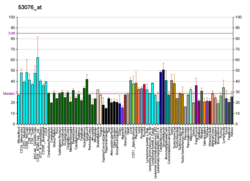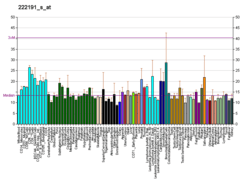B4GALT7
Beta-1,4-galactosyltransferase 7 also known as galactosyltransferase I is an enzyme that in humans is encoded by the B4GALT7 gene.[5][5][6][6][7] Galactosyltransferase I catalyzes the synthesis of the glycosaminoglycan-protein linkage in proteoglycans.[8] Proteoglycans in turn are structural components of the extracellular matrix that is found between cells in connective tissues.
Function
Galactosyltransferase I is one of seven β-1,4-galactosyltransferase (β4GalT) enzymes. These enzymes are type II membrane-bound glycoproteins that appear to have exclusive specificity for the donor substrate UDP-galactose; all transfer galactose in a β-1,4 linkage to similar acceptor sugars: GlcNAc, Glc, and Xyl. Each beta4GalT has a distinct function in the biosynthesis of different glycoconjugates and saccharide structures. As type II membrane proteins, they have an N-terminal hydrophobic signal sequence that directs the protein to the Golgi apparatus and which then remains uncleaved to function as a transmembrane anchor. By sequence similarity, the beta4GalTs form four groups: β4GalT1 and β4GalT2, β4GalT3 and β4GalT4, β4GalT5 and β4GalT6, and β4GalT7. The enzyme encoded by this gene attaches the first galactose in the common carbohydrate-protein (GlcA-β-1,3-Gal-β-1,3-Gal-β-1,4-Xyl-beta1-O-Ser) linkage found in proteoglycans. Manganese is required as a cofactor. This enzyme differs from the other six beta4GalTs because it lacks the conserved β4GalT1-β4GalT6 Cys residues and it is located in cis-Golgi instead of trans-Golgi.[7]
Clinical significance
Mutations in the B4GALT7 gene that result in a defective galactosyltransferase I enzyme with reduced or absent activity are associated with Spondylodysplastic, formerly progeroid type Ehlers-Danlos syndrome.[6][8][9][10] The reduced activity of B4GALT7 is associated with a reduced substitution of the proteoglycans decorin and biglycan with glycosaminoglycan carbohydrate chains, and with alterations in heparan sulfate biosynthesis, resulting in delayed wound repair, altered migration, adhesion and contractility of patient fibroblasts.[11][12] Since mutations in B4GALT7 impair a glycosylation pathway, the resulting subtype of Ehlers-Danlos syndrome may be considered a congenital disorder of glycosylation (CDG), according to the new CDG nomenclature.
Mutations in B4GALT7 cause Larsen syndrome.[13]
References
- GRCh38: Ensembl release 89: ENSG00000027847 - Ensembl, May 2017
- GRCm38: Ensembl release 89: ENSMUSG00000021504 - Ensembl, May 2017
- "Human PubMed Reference:". National Center for Biotechnology Information, U.S. National Library of Medicine.
- "Mouse PubMed Reference:". National Center for Biotechnology Information, U.S. National Library of Medicine.
- Okajima T, Yoshida K, Kondo T, Furukawa K (August 1999). "Human homolog of Caenorhabditis elegans sqv-3 gene is galactosyltransferase I involved in the biosynthesis of the glycosaminoglycan-protein linkage region of proteoglycans". The Journal of Biological Chemistry. 274 (33): 22915–8. doi:10.1074/jbc.274.33.22915. PMID 10438455.
- Almeida R, Levery SB, Mandel U, Kresse H, Schwientek T, Bennett EP, Clausen H (September 1999). "Cloning and expression of a proteoglycan UDP-galactose:beta-xylose beta1,4-galactosyltransferase I. A seventh member of the human beta4-galactosyltransferase gene family". The Journal of Biological Chemistry. 274 (37): 26165–71. doi:10.1074/jbc.274.37.26165. PMID 10473568.
- "Entrez Gene: B4GALT7 xylosylprotein beta 1,4-galactosyltransferase, polypeptide 7 (galactosyltransferase I)".
- Okajima T, Fukumoto S, Furukawa K, Urano T (October 1999). "Molecular basis for the progeroid variant of Ehlers-Danlos syndrome. Identification and characterization of two mutations in galactosyltransferase I gene". The Journal of Biological Chemistry. 274 (41): 28841–4. doi:10.1074/jbc.274.41.28841. PMID 10506123.
- Quentin E, Gladen A, Rodén L, Kresse H (February 1990). "A genetic defect in the biosynthesis of dermatan sulfate proteoglycan: galactosyltransferase I deficiency in fibroblasts from a patient with a progeroid syndrome". Proceedings of the National Academy of Sciences of the United States of America. 87 (4): 1342–6. doi:10.1073/pnas.87.4.1342. PMC 53471. PMID 2106134.
- Furukawa K, Okajima T (December 2002). "Galactosyltransferase I is a gene responsible for progeroid variant of Ehlers-Danlos syndrome: molecular cloning and identification of mutations". Biochimica et Biophysica Acta (BBA) - General Subjects. 1573 (3): 377–81. doi:10.1016/S0304-4165(02)00406-3. PMID 12417421.
- Seidler DG, Faiyaz-Ul-Haque M, Hansen U, Yip GW, Zaidi SH, Teebi AS, et al. (July 2006). "Defective glycosylation of decorin and biglycan, altered collagen structure, and abnormal phenotype of the skin fibroblasts of an Ehlers-Danlos syndrome patient carrying the novel Arg270Cys substitution in galactosyltransferase I (beta4GalT-7)". Journal of Molecular Medicine. 84 (7): 583–94. doi:10.1007/s00109-006-0046-4. PMID 16583246.
- Götte M, Spillmann D, Yip GW, Versteeg E, Echtermeyer FG, van Kuppevelt TH, Kiesel L (April 2008). "Changes in heparan sulfate are associated with delayed wound repair, altered cell migration, adhesion and contractility in the galactosyltransferase I (beta4GalT-7) deficient form of Ehlers-Danlos syndrome". Human Molecular Genetics. 17 (7): 996–1009. doi:10.1093/hmg/ddm372. PMID 18158310.
- Cartault F, Munier P, Jacquemont ML, Vellayoudom J, Doray B, Payet C, et al. (January 2015). "Expanding the clinical spectrum of B4GALT7 deficiency: homozygous p.R270C mutation with founder effect causes Larsen of Reunion Island syndrome". European Journal of Human Genetics. 23 (1): 49–53. doi:10.1038/ejhg.2014.60. PMC 4266744. PMID 24755949.
External links
- Human B4GALT7 genome location and B4GALT7 gene details page in the UCSC Genome Browser.
- PDBe-KB provides an overview of all the structure information available in the PDB for Human Beta-1,4-galactosyltransferase 7
Further reading
- Amado M, Almeida R, Schwientek T, Clausen H (December 1999). "Identification and characterization of large galactosyltransferase gene families: galactosyltransferases for all functions". Biochimica et Biophysica Acta (BBA) - General Subjects. 1473 (1): 35–53. doi:10.1016/S0304-4165(99)00168-3. PMID 10580128.
- Seidler DG, Faiyaz-Ul-Haque M, Hansen U, Yip GW, Zaidi SH, Teebi AS, et al. (July 2006). "Defective glycosylation of decorin and biglycan, altered collagen structure, and abnormal phenotype of the skin fibroblasts of an Ehlers-Danlos syndrome patient carrying the novel Arg270Cys substitution in galactosyltransferase I (beta4GalT-7)". Journal of Molecular Medicine. 84 (7): 583–94. doi:10.1007/s00109-006-0046-4. PMID 16583246.
- Gulberti S, Lattard V, Fondeur M, Jacquinet JC, Mulliert G, Netter P, et al. (January 2005). "Phosphorylation and sulfation of oligosaccharide substrates critically influence the activity of human beta1,4-galactosyltransferase 7 (GalT-I) and beta1,3-glucuronosyltransferase I (GlcAT-I) involved in the biosynthesis of the glycosaminoglycan-protein linkage region of proteoglycans". The Journal of Biological Chemistry. 280 (2): 1417–25. doi:10.1074/jbc.M411552200. PMID 15522873.
- Kuroiwa A, Matsuda Y, Okajima T, Furukawa K (2000). "Assignment of human xylosylprotein beta-1,4-galactosyltransferase gene (B4GALT7) to human chromosome 5q35.2-->q35.3 by in situ hybridization". Cytogenetics and Cell Genetics. 89 (1–2): 8–9. doi:10.1159/000015578. PMID 10894925.
- Kresse H, Rosthøj S, Quentin E, Hollmann J, Glössl J, Okada S, Tønnesen T (September 1987). "Glycosaminoglycan-free small proteoglycan core protein is secreted by fibroblasts from a patient with a syndrome resembling progeroid". American Journal of Human Genetics. 41 (3): 436–53. PMC 1684193. PMID 3631078.





